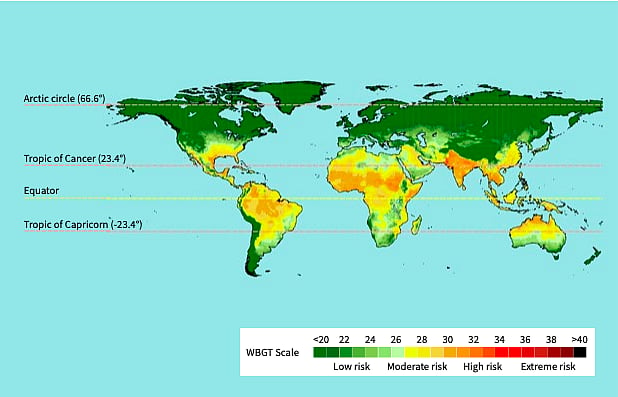Why in News?
A joint report by the World Health Organization (WHO) and the World Meteorological Organization (WMO) warns that extreme heat is becoming a major occupational health crisis globally.
- Released amid record-breaking global temperatures (2024 being the hottest year ever), the report urges urgent action to protect workers from heat stress and related health risks.
Key Issues Highlighted
1. Health Risks to Workers:
- Extreme heat causes:
- Heatstroke, dehydration
- Long-term brain and kidney disorders
- Higher miscarriage risk for pregnant women working in hot conditions
- Vulnerable groups include:
- Middle-aged and older workers
- Those with chronic illnesses or low physical fitness
2. Productivity Loss:
- Worker productivity drops 2–3% for every degree above 20°C.
- Particularly severe in outdoor work and uncooled indoor spaces.
3. Occupational Crisis:
- Heat stress is now a widespread occupational hazard.
- Nearly 50% of the global population faces adverse impacts from extreme heat.
4. Policy and Preparedness Gaps:
- Lack of tailored heat safety policies in many countries.
- Many climate adaptation strategies fail due to:
- Ignoring cultural contexts
- Overlooking gendered work burdens
- Failing to address economic inequality
Recommendations from the Report:
- Policy Development:
- Establish workplace heat-health guidelines based on local weather and job nature.
- Focus on Vulnerable Groups:
- Prioritize protection for older workers, those with health conditions, and the economically disadvantaged.
- Awareness and Training:
- Educate employers, workers, and healthcare professionals on recognising and treating heat stress.
- Use of Technology:
- Leverage innovations (e.g., wearable tech, climate-responsive infrastructure) to maintain productivity and health.
- Localized & Equitable Adaptation:
- Design solutions that fit local socio-cultural realities and ensure economic justice.
World Health Organization (WHO):
Headquarters:
- Geneva, Switzerland
Established:
- 1948, as a specialized agency of the United Nations.
Mandate:
- Acts as the global authority on public health.
- Coordinates international health responses, sets health standards, and monitors disease trends.
Key Functions:
- Global health policy development and coordination.
- Monitoring and responding to epidemics/pandemics (e.g., COVID-19).
- Supporting countries in building resilient health systems.
- Promoting universal health coverage, mental health, and maternal/child health.
- Publishing the International Classification of Diseases (ICD).
World Meteorological Organization (WMO):
Headquarters:
- Geneva, Switzerland
Established:
- 1950, evolving from the International Meteorological Organization (IMO), and became a UN specialized agency in the same year.
Mandate:
- Provides international coordination on atmospheric science, climate monitoring, weather forecasting, and water resources.
Key Functions:
- Standardizing meteorological data collection and dissemination worldwide.
- Monitoring and reporting on climate change, natural disasters, and weather extremes.
- Supporting early warning systems for floods, droughts, cyclones, and heatwaves.
- Works closely with national meteorological and hydrological services (NMHSs), like IMD (India Meteorological Department).
Conclusion
The WHO-WMO report frames extreme heat as an escalating global health and labor crisis, disproportionately impacting vulnerable populations. Without urgent policy reform, targeted interventions, and inclusive climate adaptation, the world risks increased illness, mortality, and economic loss. To safeguard human health and dignity in a warming world, heat must be treated as a core occupational hazard, not just an environmental one.







